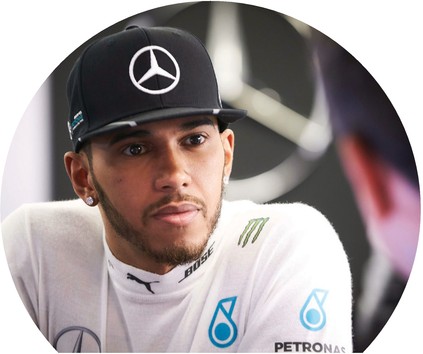REG 2 CAT MAN
Category: Editor’s Letter
REG1 CAT DAT
REG1 CAT DAT
H new REG
H new REG
MATTERS OF MOMENT

Lewis Hamilton has just returned from his longest break, from F1, in 10 years. Since his 2017 campaign ended at Abu Dhabi in November, he has been snowboarding in the USA (“It was icy in Colorado – too dangerous”), then more snowboarding in Japan (“We didn’t have any snow”), then surfing in Hawaii (“Not the greatest surfer yet, but it’s good for working out”).
He looks absurdly fit and healthy, but he smooths down the front of his race suit and admits that the aim is “to keep the same strength but lose some of the fat for the first race”. I look at him and wonder: what fat?
We’re at Silverstone, at the launch of the car that could allow him to match the five world titles won by Fangio and Michael Schumacher. To do it, he’ll have to beat Sebastian Vettel – another man chasing his fifth. But does this matter, does Lewis chase numbers?
“I saw something in the last few days about being up with Fangio and that is an exciting prospect, but honestly when I left Abu Dhabi and when I’m with my family, I don’t have a single thought about racing. It helps that I had no one reminding me that I’m a four-time champion – so I went back to reality.
“Then I went into the new year, started training, and you ask, ‘Why are you training? What are your goals?’ It’s not as simple as writing it down – you have to find out where you’ll find your determination and drive.”
He says he is better prepared for 2018 than ever, but admits that he needs to find ways of “getting through” the training. Listening to music helps, he says, but – as you would expect of a racing driver – he can’t sit still. Surfing, snowboarding, jogging, Lewis needs to keep moving.
Until last year, however, perhaps the only chink in Lewis’s armour was psychological – not physical. Dramas in his personal life seemed to affect his racing, and there were Grands Prix when he just didn’t seem to turn up. He’s had another drama in his personal life this winter, with a misguided Instagram post and subsequent winding down of his social media activity. Did this affect him?
“We had already planned to have a clean slate [on social media] at the beginning of this year – it just turned out it was an opportunistic [sic] time. I have been very open with my life for several years, and it’s always difficult to make a change because I like being open. But we are living in a strange time in the world, when things are magnified a lot more than previous years. It will continue to be part of my life, to connect with fans, but maybe I’ll be a bit more strategic in what I do and don’t show.”
How then does he handle the pressure of being in the spotlight? “For me, to get around a stressful scenario I go for a run. It helps me work out solutions. Trying to live my best life very day. We all handle different scenarios in different ways. Our journey is determined by how much you put into it.
“I put a lot of positive people around me. I don’t put people around me who suck my energy. I only have people around me who make my light brighter. You’ve got to remember that life is a challenge for all of us. We all come across hurdles. It’s not how you fall it’s how you stand up. We have Billy Monger here, and he is racing British F3 this year – so anything is possible.

“When I’m racing it’s easy. I put on the helmet, put on the blinkers and enter a different zone.”
What about mind games. If he feels threatened by another driver, does he then look away from ‘self’ and see if he can affect the performance of others? His reply is brusque, but satisfyingly so. “Honestly I don’t play mind games; I just drive faster….”
He admits that he “tries to veer off negativity” but his body language shifts when the discussion moves to the weight of the current F1 cars. Accommodating the new halo device has forced the rulemakers into increasing the minimum weight by 6kg (to 734kg) to compensate, but the actual impact of the device including the mountings is thought to be as high as 14kg – much of which is placed high-up, thus affecting the centre of gravity. When Hamilton won his first F1 world championship, in 2008, the cars weighed 605kg…
“Cars are getting heavier,” says Lewis, “and after braking zones, brakes are on the limit. I hope things don’t get heavier. There are parts about lighter cars I prefer – like they’re easier to manoeuvre in combat…”
Nice line, that. Say what you like about Lewis the man, but he’s always been a racer.
Our next issue is on sale from March 30
EVEN NEWER EDITORS LETTER
EVEN NEWER EDITORS LETTER
hughie
asd
ed let 1
ed let 1
The MFers
Jon, brand director
#MustTriHarder
I’m not a big fan of isolation lifts, much preferring heavy compound moves. But to add muscle faster I’ve embraced single-joint moves, like cable triceps press-downs. The aim is to keep tension on the muscle throughout each set and get the biggest pump possible.
Ben, deputy editor
#JointEffort

I’ve been working on improving my hip, knee and ankle joint mobility using a squat progression devised by movement coach Ido Portal. I’ve suffered with knee pain ever since tearing a cruciate ligament a few years ago during an MMA sparring session, but increasing my ROM has worked wonders relieving it.
Joe, editorial director
#ShoulderTheBurden

I’ve been spending more gym time on my shoulders: firstly working on improving mobility, then doing slow and controlled reps to work the muscles hard, but in a safer way that doesn’t risk injury. After all, what use are bigger shoulders if you can’t raise your arms?
Sam, fitness editor
#BattleReady

I tested the new Under Armour HealthBox, an activity band, heart rate monitor and smart scale combo, at GSK’s Human Performance Lab. I can conclusively report 30 seconds of manic battle rope thrashing is sufficient to reach max heart rate — and break this fitness journo. Read the MF review on p31.
The time for change
It’s said a change is as good as a rest – but in the pursuit of living a better life, I’d say stepping up is far more beneficial than lying down. This issue of Men’s Fitness has one theme running from the first page to the last, and it’s the importance of trying to do things differently. To do things better.
Inside we bring you an interview with Rudimental’s DJ Locksmith, fresh from a 30-day fat-loss challenge (p33). We put the spotlight on action hero Matt Damon, who’s rolled back the years to reprise his role as Jason Bourne (p46). And we’ve got an exclusive training feature with golf superstar Rory McIlroy, whose new-found love of lifting weights has driven his career to incredible heights (p68).
You’ll read a lot of instantly applicable training, nutrition and life tips from these men, who’ve put their reputations and bodies on the line to dominate the stage, the screen and the green.
But the beauty of change is that it’s all relative. For you to lead to a fitter, healthier and happier life, all it takes is small steps in the right direction. Start today and those little steps will soon make a big difference.

Joe Warner, editorial director @JoeWarnerUK
Vote ‘Remain’ for farming prosperity
People entering a voting booth on 23 June will be taking part in arguably the most important political event in a generation.
Farmers Weekly has been biding its time trying to ascertain what would be the best outcome from this historic referendum on the UK’s future membership of the European Union.
Even though our hunch has always been that a “Remain” vote would be the best option for farming, we were keen to hear more from the “Leave” camp.
Over recent weeks we have explored the four most important elements of the debate – trade, support, labour and regulation. Each has its own complexities, but in each case, the weight of argument seems to come down in favour of “Remain”.
Take trade. Leave campaigners say there is nothing to worry about; the UK will find new outlets beyond Europe, while the EU will also be keen to do a free-trade deal with us. In time, that may be possible. The more likely outcome, however, is that, in a post-Brexit world, the UK government would seek even greater trade liberalisation, cutting tariffs and exposing farmers to tougher competition from the world’s cheapest producers.
Similarly on farm support, there have been many promises from the Leave camp that, with money no longer going to Brussels, the UK government will be well-placed to spend more on farmers and rural businesses. That is unlikely. The UK government’s track record in Europe has been to rein in subsidies. It is easy to imagine a post-Brexit world in which British farmers have to compete with their EU neighbours, but without the same direct payments.
On labour, it is easy to sympathise with the desire to see tighter controls on our borders. But the big concern here is the extent to which British agriculture is dependent on migrant labour, especially from other EU member states. Limiting access may impact the ability to harvest certain crops, and will certainly drive up costs.
Finally, there is regulation. Again, the Leave campaigners talk of cutting red tape and designing a system better suited to our needs. But history tells us civil servants in Westminster are every bit as enthusiastic as their counterparts in Brussels when it comes to designing over-complex rules and regulations. They also have a penchant for gold plating.
Despite all this, the reader survey we conducted in April suggested a majority of grassroots farmers still want out.
But what was also clear from our survey was that those farmers who want to leave the EU are influenced by issues that go beyond the farmgate – sovereignty, immigration and national security, to name but a few.
That is as it should be. Clearly, standing in the voting booth on 23 June will be a personal, even emotional, experience. Multiple factors will have to be considered. Gut feeling will also play a part.
But if farming prosperity is your number-one concern, then a vote to remain seems to be the preferable option.
Philip Clarke Executive editor